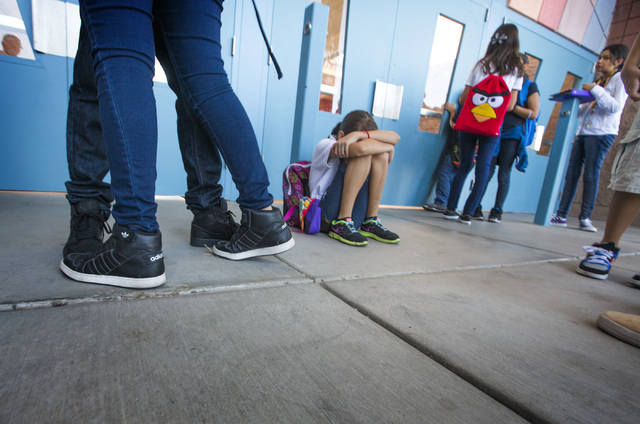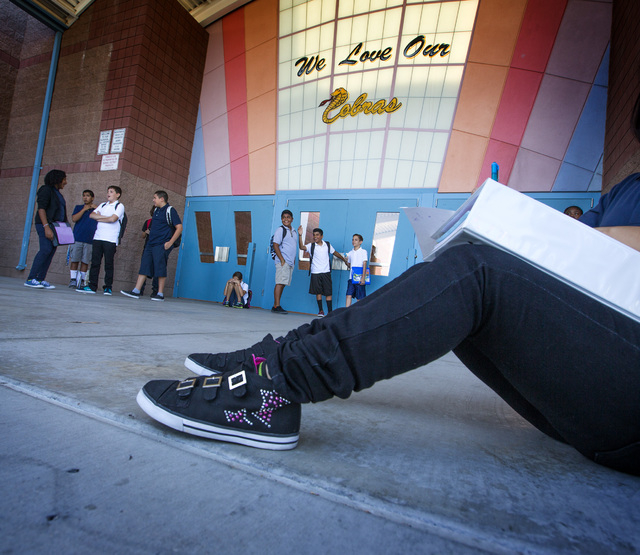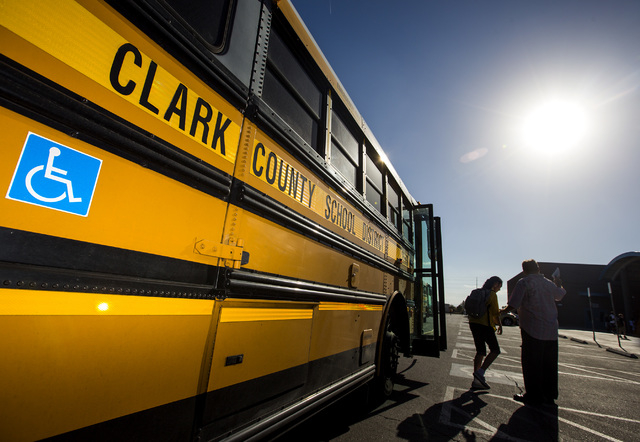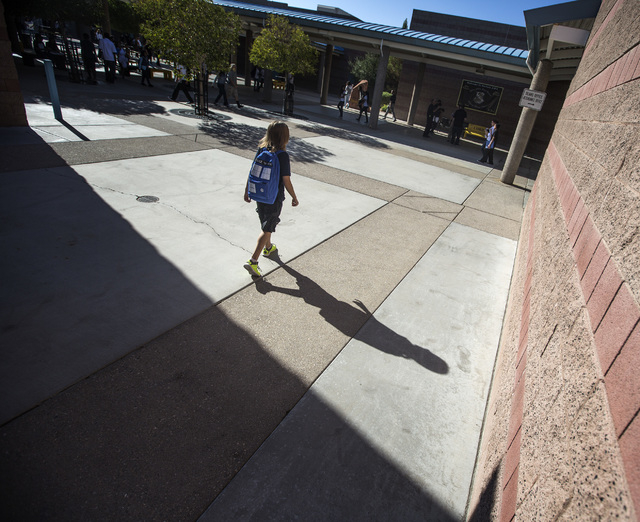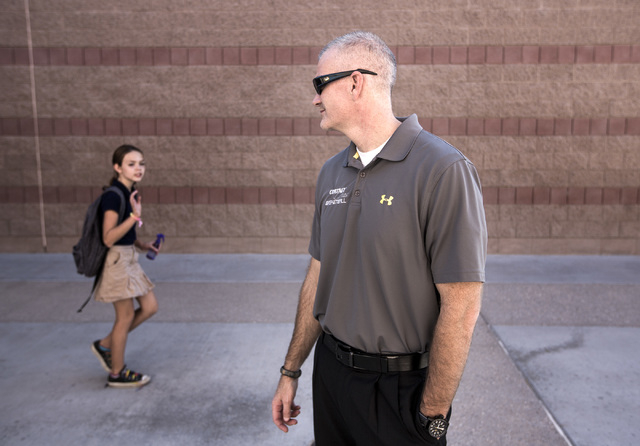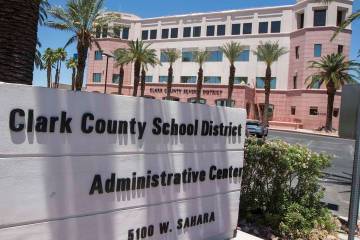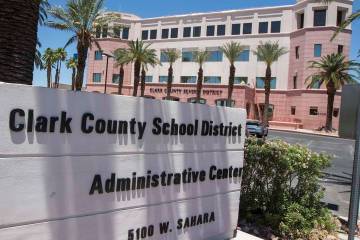Later starts considered for Clark County schools
The morning bell won’t ring until 9 a.m. at the earliest for any Nevada middle or high school if one state lawmaker has his way.
Sen. Tick Segerblom, D-Las Vegas, drafted a bill request for the 2015 Legislature that would require Clark County to stall bell times by an hour or two for 106 schools. The measure would likely cost millions of dollars more in bus transportation.
“From a business standpoint, you can argue that the earlier school starts, the better,” said Segerblom, who is aware of the transportation savings accrued by staggering bell times. “It goes back to Nevada and how cheap we are. But (adolescent) students need to go to school later.”
Segerblom was motivated by an Aug. 25 report from the American Academy of Pediatrics that recommended bell times of 8:30 a.m. or later for middle and high school students. The academy found that a majority of adolescents sleep less than the recommended 8.5 to 9.5 hours needed for healthy mental and physical development.
“Evidence strongly suggests that a too-early start to the school day is a critical contributor to chronic sleep deprivation,” said the academy, which found that only 15 percent of U.S. high schools start at 8:30 a.m. or later.
ONE SCHOOL’S EXPERIENCE
What sounds good on paper has proven an “absolute nightmare” for Clark County School District’s Cortney Junior High School, which changed its start time from 8 a.m. to 9:10 a.m. in 2011-12, according to Principal David Rose. Classes start more than an hour later, but Cortney has experienced no decrease in morning tardies.
Student absences, however, have tripled for sixth period, the last of the day, as parents pull students for doctor’s appointments and other reasons. The later start means a later end, with students leaving at 3:21 p.m. instead of 2:11 p.m. Teachers are even taking more half-days to cover afternoon appointments they could previously fit in after school.
Participation in extracurricular activities has plummeted because families are anxious about children “walking home when it’s pitch dark,” said Rose, who oversees the campus on Hacienda Avenue near Nellis Boulevard.
Principal, teachers and staff also have found many students still arrive early despite the later bell time, not catching the additional sleep hoped for by the pediatricians academy.
“I don’t buy it,” Rose said of the academy’s reasoning for later bell times.
He’s seen it firsthand — many parents still have to be at work by 8 a.m. “Their schedule didn’t change,” so they continue to drop off their children at school at 7:30 a.m., he said.
“Students are here before me, sitting in front for an hour and a half,” said Rose, who’s been in contact with other secondary school principals whose schools were moved to later bell times three years ago. “We are having the same problems. It’s across the board. Our kids are suffering.”
Rose has tracked the evidence at Cortney and brought his findings to the district to support his case for a return to an earlier school day.
“We have tried and tried to get it changed. Give me a small shift, 8:30 a.m. or even 8:40 a.m.,” said Rose, who keeps hearing “no” from district officials.
What was 411 sixth-period student absences during the final year of the early school day tripled to 1,125 absences the first year of the later start time.
The 381 students in after-school clubs and programs fell to 215 students in the same time period. The number of clubs decreased from 12 to seven. Student test scores have actually decreased with the later school day, which could be due to bell times as well as other factors.
LATER STARTS ON THE WAY
Money is why the district changed the bell times at Cortney and 138 other schools in 2011-12. It saved $10 million at a time when $411 million was being slashed from the district budget. Altered bell times allowed bus drivers to complete more routes, cutting the district’s 1,500 bus fleet by 200 vehicles.
About 89 percent, or 106 of Clark County’s 122 middle and high schools, currently start before 9 a.m. Only eight of those schools start at 8:30 a.m. or later, with most middle schools starting at 8 a.m. and high schools starting about 7 a.m.
Money may have been the driving force in 2011-12, but the district is considering another bell-time shift for 2015-16, whether Segerblom’s bill passes or not. And this time it will be done with academics in mind, Chief Student Achievement Officer Mike Barton said.
The district is considering moving more bell times back to 8:30 a.m. and 9 a.m., disregarding Cortney’s bad experience as anecdotal evidence, Barton said.
“We don’t have data that shows us, either way,” said Barton, who will bring a proposal to the Clark County School Board in December seeking a pilot program for later school days at more secondary schools to see if academic performance improves. His department will also present findings on the academic performances of the few late-start schools it currently operates. “We’re looking at the research that is coming out and paying attention.”
But school officials aren’t united in support of later bell times.
PROS, CONS for later bell times
Jeff Horn is now an assistant chief student achievement officer for the district, but he was a fixture at Henderson’s Green Valley High School for 23 years. He was principal in 2011-12 when the school shifted from a 7:05 a.m. start time to 8 a.m. He ran the campus for the three years that followed, witnessing the benefits.
Students were no longer waking at 4:30 a.m. to make 6 a.m. early-bird classes in the dark.
Marching band was no longer told to be quiet because of the city’s noise ordinance in the early morning.
“With teenagers, especially, it worked out well,” said Horn, who doubts students get much more sleep. “They’ll just stay up later. But it’s better overall. You see the alertness in kids by being able to wake later.”
But he wouldn’t want a 9 a.m. start time and doesn’t want to impose that on all secondary schools.
“There’s a lot of moving parts for transportation, after-school activities and athletics,” he said. “It’s a big puzzle.”
That’s especially true for a district the size of Clark County, fifth-largest in the nation with 357 schools and 320,000 students.
“We’re not a small district,” said Trent Day, principal of Centennial High School, whose school has long started at 7 a.m.
And he doesn’t have attendance problems at Centennial, near the 215 Beltway and Hualapai Way. Centennial has about 3,000 students and sees only 15 to 30 tardies a day, he said. Better teaching is what keeps students alert, he said.
“The days of sitting here 85 minutes and listening are over,” said Day, whose teachers are trained on more interactive teaching. “We get them moving, involved.”
At 81 percent, Centennial has one of the district’s highest graduation rates among traditional high schools. An earlier start also allows many Centennial students to work after school, he said. In talking to later-starting schools, he’s learned that some instructional time would also be lost to bus scheduling.
“The repercussions of moving to 9 a.m. in Las Vegas with our huge transportation system, I would be opposed,” Day said. “Kids would get home in the dark. I know they now sometimes come to school in the dark, but that’s a little different, not as bad.”
Contact Trevon Milliard at tmilliard@reviewjournal.com or 702-383-0279. Follow @TrevonMilliard on Twitter.



